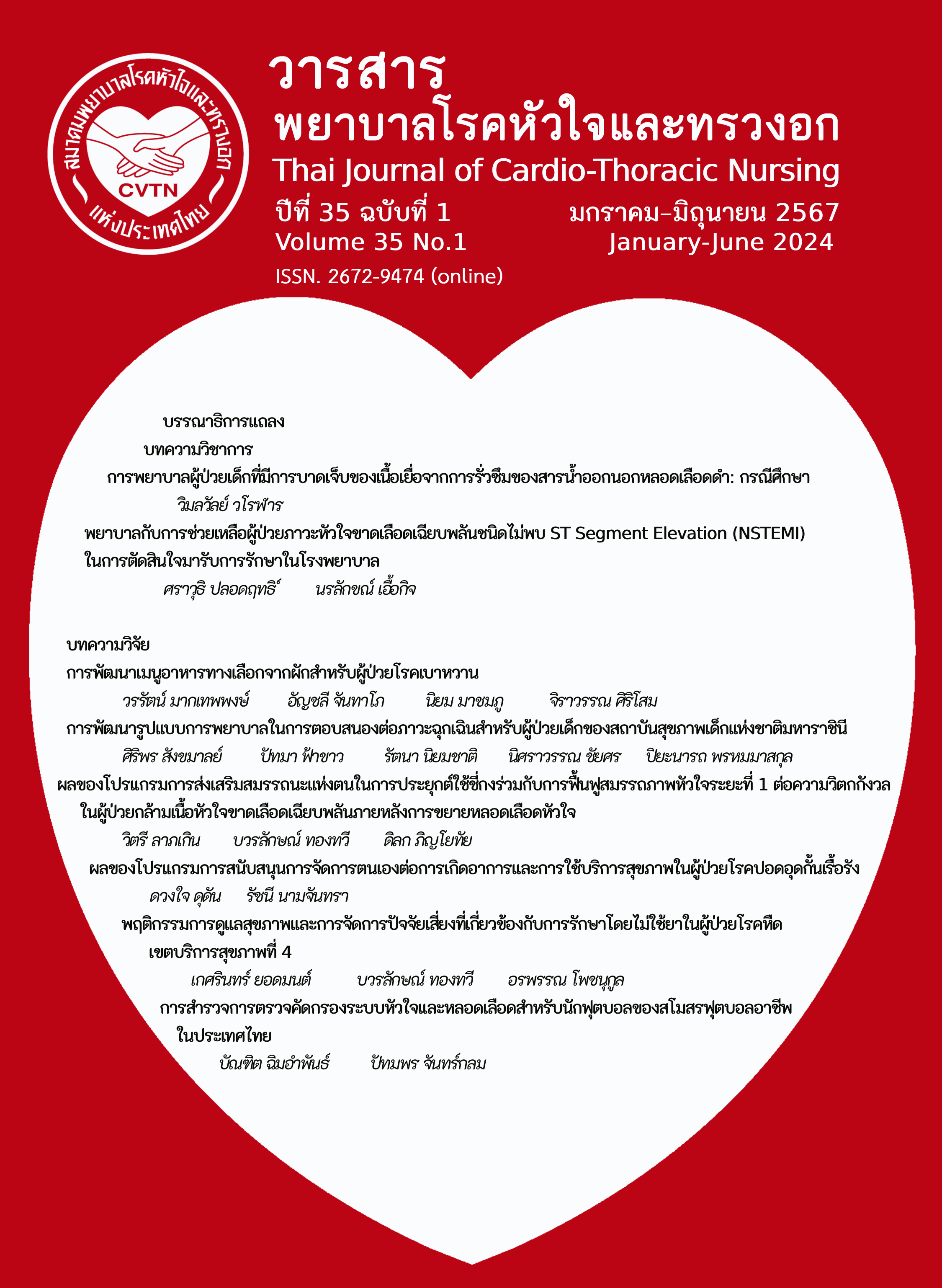Development of an emergency response nursing model for pediatrics at Queen Sirikit National Institute of Child Health
Keywords:
research and development, a model of emergency response, pediatric early warning systemAbstract
This study utilized a research and development framework to develop a model and evaluate the effectiveness of an emergency response nursing model for pediatrics at Queen Sirikit National Institute of Child Health. The sample included 625 control group and 628 experimental group pediatric patients, as well as 46 professional nurses. The model was developed using the 3P-PDSA method, which was divided into four phases. Phase 1: conducting a situation analysis and factors that affected the inappropriate emergency response of pediatric patients. The control group data were collected from the medical records of all patients admitted to the three wards. Phase 2: developing an assessment tool using Pediatric Early Warning Scores (PEWS). Nurses were on a 6-month job training period to familiarize themselves with the tools before applying them to patients. Phase 3: comparing results between the control and experimental groups. Phase 4: evaluating and adapting the model to each unit's specific situations and contexts.
The findings revealed that the emergency response nursing model comprised assessment tools such as an escalation guide, and communication guidelines for multidisciplinary teams. A comparison between previous nursing responses and emergency responses indicated: 1) a significant difference in unplanned admissions to the Pediatric Intensive Care Unit (PICU) (P< 0.05). 2) There is no statistically significant difference in the number of resuscitations and deaths among pediatric patients (p > 0.05), as determined by Fisher’s Exact Test. 3) Nurses in the experimental group expressed high to very high satisfaction levels with the emergency response assessment model.
This study suggested that this emergency response nursing model effectively enhances the emergency response for pediatric patients and should be applied in other healthcare settings to decrease the mortality rate.
References
World Health Organization. 10 facts on patient safety [homepage on the Internet]. WHO: Geneve; The Institute; 2019 [cited 2021 Jul 21]. Available from: http://www.who.int/features/factfiles/patient_safety/patient_safetyfacts/en/index1.html.
The Healthcare Accreditation Institute (Public Organization). Patient safety goals: SIMPLE Thailand 2018 [homepage on the Internet]. Nonthaburi; The Institute; 2018 [cited 2021 Apr 21]. Available from: http://134.236.247.146:8080/edoc1/uploads/DocNum_20211110172458.pdf. (in Thai).
Winters BD, Weaver SJ, Pfoh ER, Yang T, Pham JC, Dy SM. Rapid-response systems as a patient safety strategy: a systematic review. Ann Intern Med. 2013 Mar 5;158(5 Pt 2):417-25. doi: 10.7326/0003-4819-158-5-201303051-00009. PMID: 23460099; PMCID: PMC4695999.
Poolpanitoopatum S, Anantasit N, Goonthon S, Pongmee P. The Effectiveness of the utilization of the rapid response system in pediatric wards at Ramathibodi Hospital. Journal of the Police Nurses. 2020; 12(2): 348-59. (in Thai).
Nahdi S. Pediatric Early Warning System (PEWS). Summary of literature review [Internet]. 2015 [cited 2021 Jul 21] Available from: https://www.childhealthbc.ca/media/78/download
The Queen Sirikit National Institute of Child Health. Patient statistics report 2017-2019. Bangkok: The Queen Sirikit National Institute of Child Health; 2019. (in Thai).
Tiamklang T. HA Concept. The Healthcare Accreditation Institute (Public Organization) [Internet]. 2017 [cited 2021 March 12]Available from: http://203.157.184.6/Newaumpher/fileupload/1310157940_HA%20concepts%20&%203C-PDSA-4-80860.pdf. (in Thai).
Cochran. WG. Sampling techniques. New York, John Wiley & Sons; 1953.
The committee of the NCEC. The Iris Pediatric Early Warning System (PEWS). User manual National clinical guideline. May 2017 [internet]. [cited 2021 Jul 21] Available from: https://assets.gov.ie/11584/b591d589d8fa4d8482ccfd8429baa0cc.pdf.
Nadsantia P, Polarsa W, Sanmit A. Developing the clinical practice guideline of pediatric early warning system in Sakon Nakhon Hospital. Journal of Sakon Nakhon Hospital. 2020; 23(1): 1-14. (in Thai).
Kaewvichien S, Waleerattanapa R, Sangkhamal S, Buaban S, Panngern P. Effect of using the Pediatric Early Warning Systems (PEWS) screening with standards of nursing for pediatric dengue hemorrhagic fever on nursing outcome in Queen Sirikit National Institute of Child Health. Journal of the Department of Medical Services. 2022;47(2): 78-85. (in Thai)
Tantapong E, Thaor S. Effects of implementing the newborn modified early warning scoring (news) in neonatal care, The Queen Sirikit National Institute of Child Health. Journal of Health and Nursing Research. 2021; 37(3): 76-103. (in Thai).
Chaleoykitti S, Kamprow P, Promdet S. Patient safety and quality of nursing service. J Royal Thai Army Nurses [Internet]. 2014 Dec. 8 [cited 2024 Apr. 21];15(2):66-70. Available from: https://he01.tcithaijo.org/index.php/JRTAN/article/view/25158 (in Thai).
Ennis L. Paediatric early warning scores on a children's ward: a quality improvement initiative. Nurs Child Young People. 2014; 26(7): 25-31.
Srikhaorot O, Prachusilpa G. Effect of using the standard of nursing care model for pediatric acute respiratory tract infection with pediatric early warning system on professional nurse’s satisfaction. Journal of Nursing Science Chulalongkorn University. 2022; 34(1): 51-64. (in Thai).
Downloads
Published
How to Cite
Issue
Section
License
Copyright (c) 2024 Thai Journal of Cardio-Thoracic Nursing

This work is licensed under a Creative Commons Attribution-NonCommercial-NoDerivatives 4.0 International License.
บทความนี้ยังไม่เคยตีพิมพ์หรืออยู่ในระหว่างส่งไปตีพิมพ์ในวารสารอื่น ๆ มาก่อน และกองบรรณาธิการขอสงวนสิทธิ์ในการตรวจทาน และแก้ไขต้นฉบับตามเกณฑ์ของวารสาร ในกรณีที่เรื่องของท่านได้ได้รับการตีพิมพ์ในวารสารฉบับนี้ถือว่าเป็น ลิขสิทธิ์ของวารสารพยาบาลโรคหัวใจและทรวงอก






